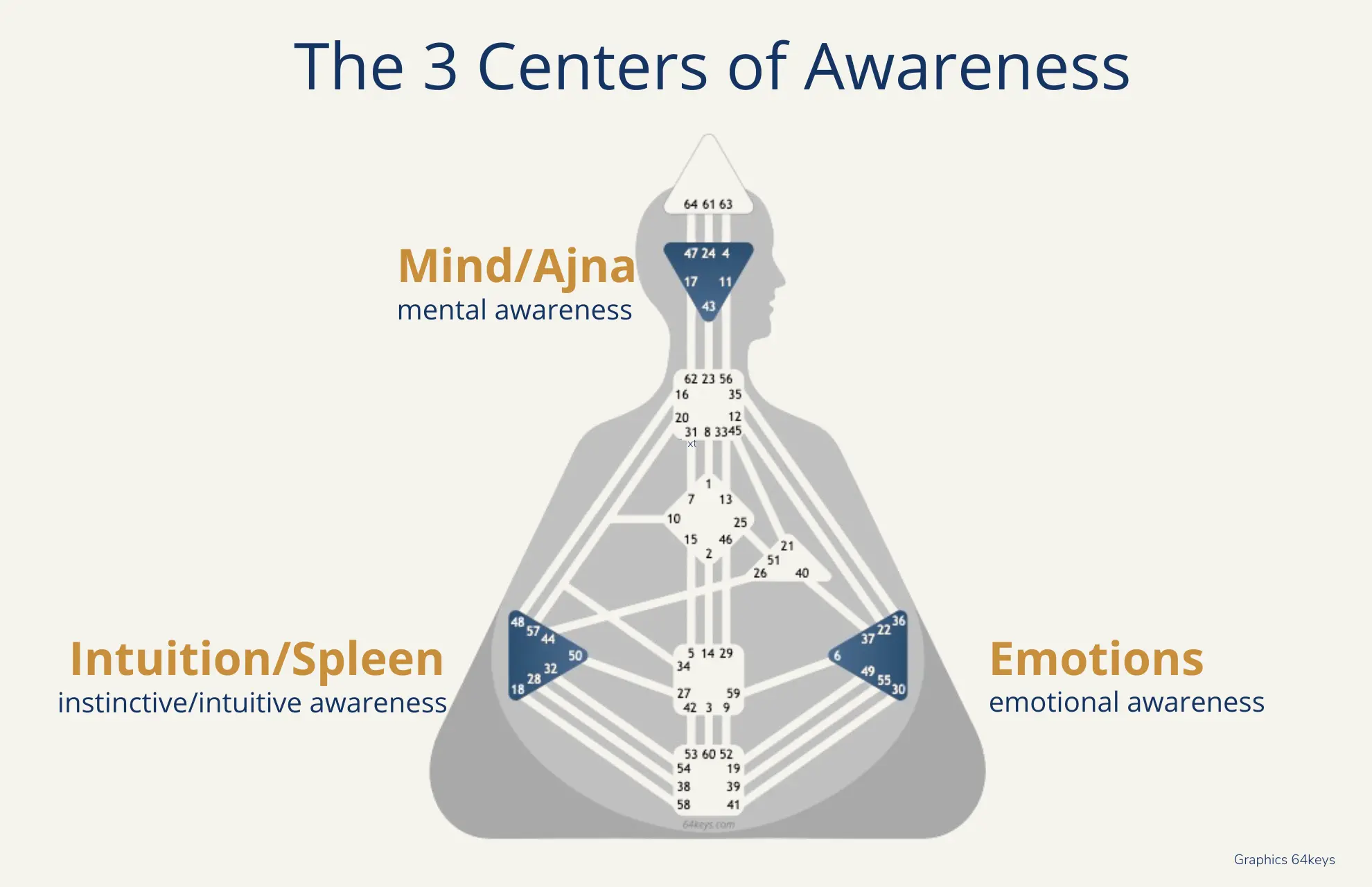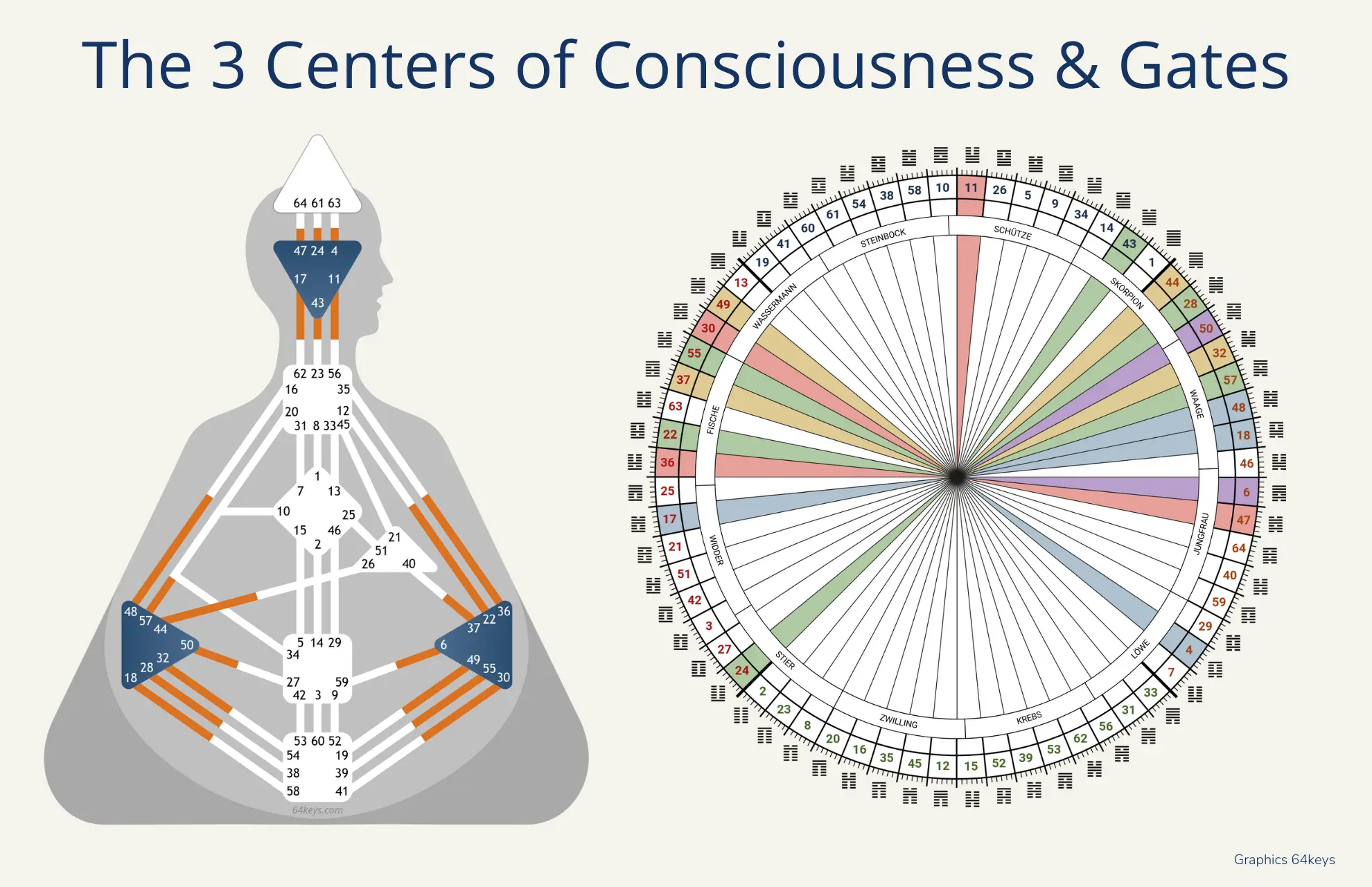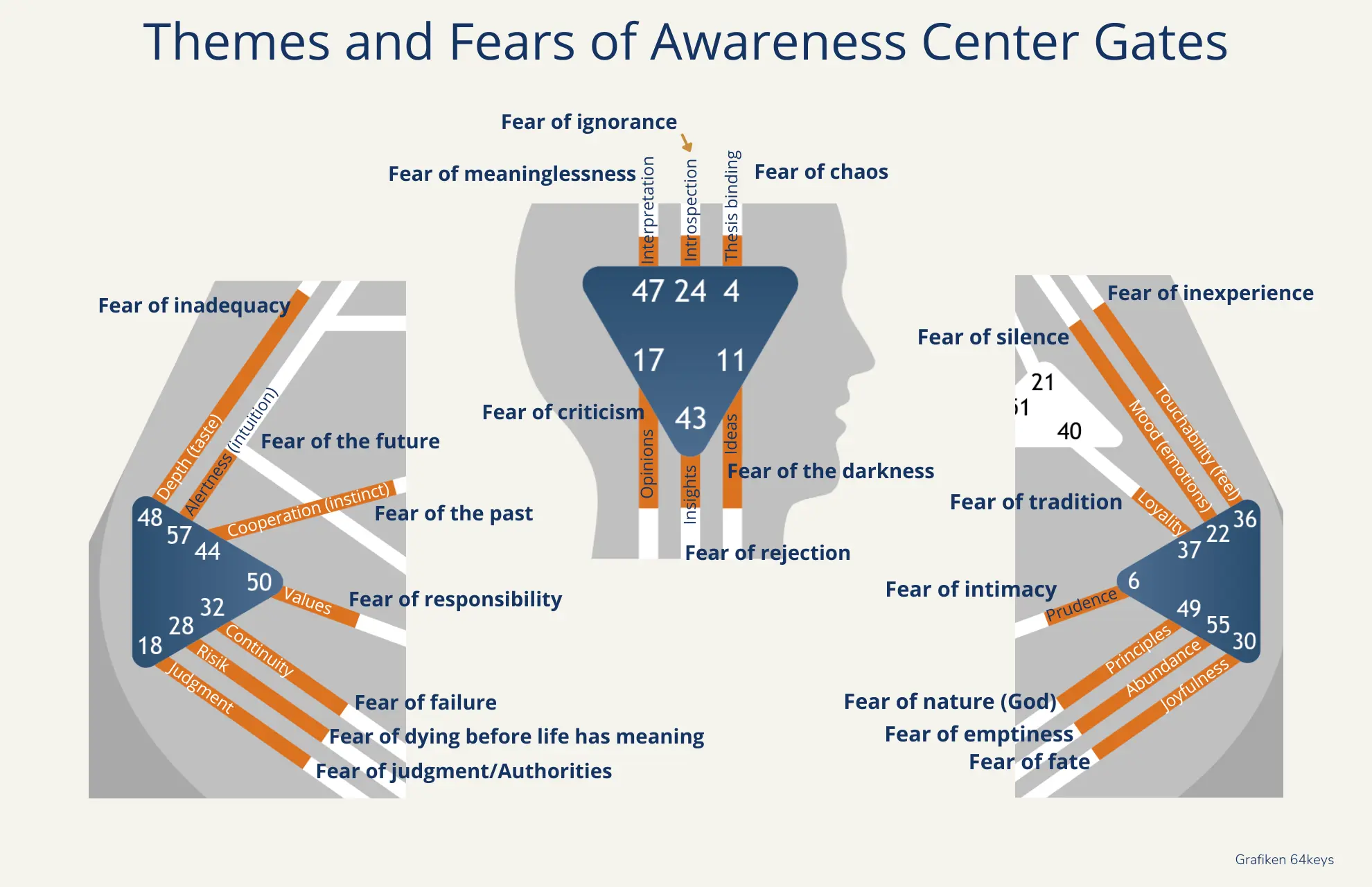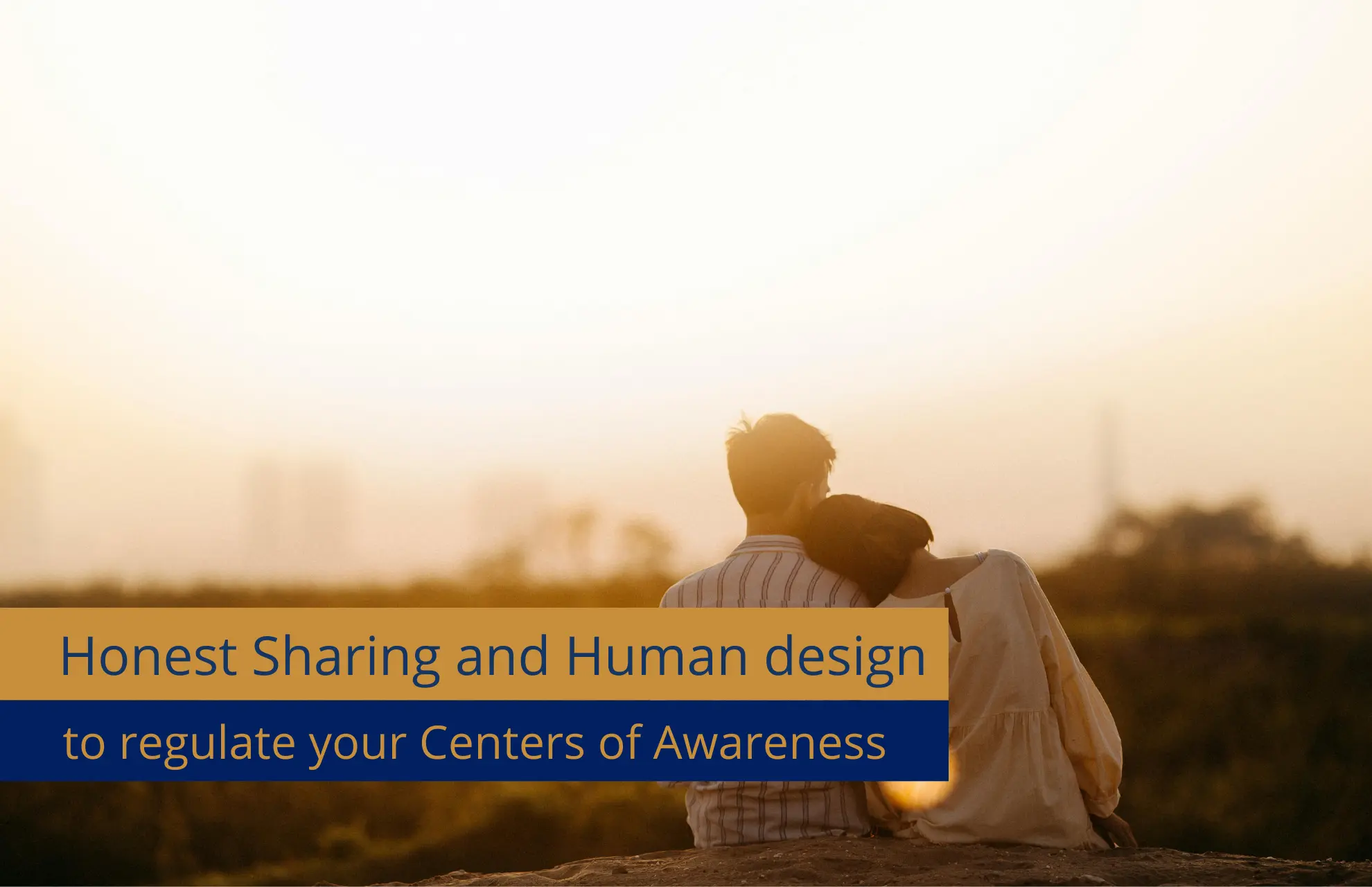Five Key Facts About Honest Sharing and Human Design
- Honest Sharing Releases Old Trauma Patterns: By consciously sharing, you emerge from isolation, allowing your nervous system to heal.
- You speak on three levels – body, thoughts, feelings: these three levels are essential for integration and self-awareness.
- These levels reflect the processing centers in Human Design: body = spleen center, thoughts = ajna center, feelings = solar plexus center.
- You don’t have to analyze or explain anything: It’s about feeling and speaking – not understanding with your head.
- The exercise is simple but transformative: And that is precisely why it will be part of my Human Design Vocation Course.
Note on Honest Sharing by Gopal
The method you will learn here comes from the book The Vagus Key to Trauma Healing* by Gopal Norbert Klein. I combined the contents with my knowledge of Human Design and developed them further. I can highly recommend the book Honest Communication According to Gopal if you want to delve deeper into the subject.
What is honest sharing?
By sharing honestly, you stop trying to solve your problems. Instead, you begin to share the feelings associated with them. It’s less a tool for self-exploration and more a guide to truly connecting within safe relationships. It’s not about spiritually figuring out who you are. It’s simply and clearly about: Are you sharing yourself – or not?
Honest sharing is simple – but profound. It is not therapy. It is not analysis. It means getting in touch. You express what is currently alive within you. Not to explain something. But to show yourself – just as you are at the moment.
You are talking about three levels:
- What you feel physically.
- What you feel physically.
- What you feel emotionally.
What you feel emotionally.
You feel your body. You perceive the thoughts in your head. You feel the feelings that are generated within you. And you communicate this – in a setting that is safe for you. Without judgment. Without advice.
Honest sharing creates a connection with yourself and with others. It brings you out of retreat. Out of old protective patterns. You come into real contact.
Over time, your nervous system will be able to relax better and more sustainably. You become calmer, clearer, more present – you have more energy. Honest sharing is not a search for your
Why Honest Sharing Works
Many psychological problems in adulthood have their roots in childhood. Especially in the context of relationships – with parents, siblings or later partners.
A central topic here is bonding trauma. This occurs when a child is unable to experience a stable emotional connection with their caregivers over a long period of time. This is not caused by individual stressful events, but by persistent loss of contact or emotional unavailability.
The child learns that it is better not to show certain feelings. Anger, fear or sadness are suppressed – in order to secure the relationship. This strategy often persists into adulthood. The result: inner tension, withdrawal, relationship problems or a chronic feeling of being overwhelmed.
This is where honest sharing comes in. It offers a structured framework for getting back in touch – with yourself and others. By sharing what you feel physically, what you think and what you feel emotionally, your nervous system can have new experiences.
The aim is not to solve or analyze problems. It is to share what you have experienced in a safe space – without judgment or interpretation. Over time, your protective mechanisms can loosen. You will develop more self-awareness, emotional stability and relationship skills.
Shock trauma vs. developmental trauma: two types of stress
If you deal with the topic of trauma, you will quickly come across two forms: Shock trauma and developmental trauma.
Shock trauma is caused by a single, overwhelming event. For example, an accident, a sudden separation or an attack. The nervous system is so overwhelmed that it switches into a kind of emergency mode. This state can remain stored in the body – sometimes for a lifetime.
Developmental trauma is different. This is not about a single event. It is about what has not happened over a long period of time: no stable contact, no reliable attention, no emotional security.
If you repeatedly had the feeling as a child that you had to conform, that you were not seen or understood – then this can lead to developmental trauma. And early shock trauma can also turn into developmental trauma later on if the child is left alone with the consequences.
Developmental traumas affect the development of the personality. They influence how you feel, think and perceive yourself today – and how you relate to others. It is precisely because developmental trauma arises so subtly that it is often overlooked. But it has a deeper impact than we think.
The true core of many ailments: Bonding trauma
Many symptoms that adults suffer from today have a common origin: a lack of secure bonding in childhood. Bonding trauma is not caused by a single bad experience. It is caused by the ongoing experience that real contact was not possible.
Perhaps your parents were physically present – but emotionally unavailable. Perhaps you learned early on to adapt so as not to lose closeness. Perhaps you felt you were not allowed to show certain feelings.
These patterns are deeply ingrained. They influence how you experience relationships today – whether you can allow trust, how you react to closeness or how you protect yourself.
The central characteristic of bonding trauma is:
- You are in a relationship, but not in contact.
- You function, adapt – and remain alone inside.
This basic pattern carries over to partnerships, friendships and even professional relationships. You want connection, but at the same time you protect yourself from it. This costs energy – and prevents real closeness.
Bonding trauma is widespread. Most people suffer from it without realizing it.
Honest sharing is a way to start right here. By learning to communicate without losing yourself, you can slowly re-establish a relationship – and thus bring about real change.
How bonding trauma develops
Bonding trauma does not occur because parents are overwhelmed or loud. It occurs when children do not experience a stable emotional connection over a long period of time. This is often because the parents themselves are traumatized – and therefore only able to relate to a limited extent. They have to unconsciously distance themselves from the child because they are unable to cope with real contact. This rarely happens on purpose. But it has far-reaching consequences.
Children sense when they are not welcome with certain feelings. Anger, despair, sadness – all of this is warded off or suppressed by the environment. Not always loudly and obviously. It often happens subtly – through ignoring, irony or withdrawal. The child begins to reject these parts of themselves. It adapts in order to maintain the relationship with its parents.
This means: no room for genuine self-expression. No safe place to show feelings. No stable counterpart to support emotional development. This situation means constant stress for a child. Especially in the phase in which the nervous system is still developing. Over time, the child adopts the attitude of its environment. It begins to believe: My needs are wrong. I am wrong.
This inner attitude gives rise to deep, often unconscious toxic shame. A shame that later influences almost every relationship. And which prevents us from really showing ourselves.
The psychological consequences in development
Bonding trauma leaves its mark, especially if it occurs early and has an effect over a long period of time. These traces are often not immediately apparent. But they work in the background – and influence your entire life.
A child who repeatedly experiences no safe contact learns: I have to adapt in order to be loved. They begin to no longer show certain feelings – or to no longer feel them at all.
Two typical strategies emerge:
- Autonomy: withdrawal, emotional distance, withdrawal into thinking or work
- Merging: strong dependence on others, search for affirmation, fear of being alone
Both patterns are attempts to deal with the old pain – without really feeling it. Permanently suppressing your own impulses costs energy. It makes self-contact difficult and prevents genuine connection with others.
It is precisely at this point that honest sharing can enable new experiences.
Human Design meets Honest Sharing: The processing centers as a bridge
Human Design assumes that certain Human Design Centres in your body are responsible for perceiving and processing information/impressions. They are referred to as centres of consciousness. These include the spleen (physical intuition), the solar plexus center (emotional perception) and the Ajna center (mental clarity). They influence how you assess dangers, make decisions and experience your inner truth. These centers regulate how you react to external stimuli, thoughts and emotions – and how you process them.

- Body awareness → Spleen center/intuition center
- Thoughts → Ajna center
- Emotions → Emotion center
By regularly communicating these three levels, you strengthen the very centers in which old conditioning and reaction patterns often reside. Open awareness centers are often more susceptible to external influences and conditioning. Conscious regulation can therefore be particularly supportive for these centers. You can find out for yourself whether this applies to you – it is an individual process.
In the following sections, I will show you how this connection manifests itself in detail – and how you can use it for your personal development.
Body awareness and the spleen center
The spleen center in Human Design stands for body awareness, intuition and survival instincts. It processes signals that come from the body – in other words, what you feel without being able to explain it.
Many people have lost access to their body sensations. Constant tension, suppressed feelings or constant functioning make us numb to what the body actually wants to communicate.
Ehrliches Mitteilen beginnt genau hier mit der Frage: Was spürst du gerade körperlich?
Perhaps there is pressure in your stomach, a pulling sensation in your neck or simply a tremor. Such sensations are an expression of your nervous system – and often the first signs of stress, anxiety or old protective patterns.
When you learn to perceive and express them, a new connection is created: You take yourself physically seriously. This relieves the spleen center – it no longer has to sound the alarm without reason.
Especially when your spleen center is open, you are receptive to the fears of others. By consciously sharing your body, you can differentiate better: What belongs to me – and what doesn’t?
This clarity is the first step towards deconditioning. You learn to listen to your own body again – and to trust it.
Mental thoughts and the Ajna center
The Ajna center in Human Design is responsible for mental processing. This is where thoughts, beliefs, evaluations and interpretations arise.
In everyday life, much of this happens automatically. You think about yourself, about others, about what has happened – or could happen. Many of these thoughts circle around, repeat themselves or create stress.
Honest sharing brings structure here. When you share what you are thinking, you take your mind out of autopilot. You create distance from your thoughts – not by analyzing them, but by speaking them out. The ajna center is relieved because it no longer has to constantly explain or justify itself.
Whether your Ajna center is defined or open plays a role here:
- With open Ajna, you are receptive to other people’s opinions and thought patterns.
- With defined Ajna, you tend to hold on to your beliefs.
In both cases, it helps to consciously communicate your thoughts – without any claim to truth.
Simply: That’s what I’m thinking right now. Or that’s what my head is thinking right now.
It sounds simple, but it has a clarifying effect. Thoughts that are expressed lose their power. Your mind becomes freer – and your thinking more transparent.
It may help you to address your head or brain in the third person or even give it a name. This way you identify less with your thoughts, because you are not your thoughts.
Emotional Waves and the Solar Plexus Center
In Human Design, the solar plexus center is the center of feelings. It processes emotional stimuli and controls how you react emotionally to the world.
When this center is defined, you experience emotional waves. Feelings come and go – without always having a specific trigger. If it is open, you are very aware of the feelings of others – and perhaps try to avoid conflicts.
In both cases, not expressing what is going on inside you emotionally leads to inner pressure.
This is where honest sharing comes in: You state your feelings as they are. Without drama, without analysis, without justification.
For example:
- I feel sadness right now.
- I am angry.
- I feel an inner tension.
Many people have learned to suppress their feelings or to be ashamed of them. But what is not communicated remains stored in the system – often for years.
The solar plexus center can only regulate itself when emotional expression becomes possible again. Consciously sharing your feelings creates a safe space in which emotions can be expressed – without consequences or judgment.
This creates emotional clarity. You no longer have to “function” – you can simply be, with what you are feeling.
Honest sharing and human design for researchers
The centers of consciousness in Human Design each have specific gates, which are shown in the following image.

Each of these gates represents a certain aspect of life – and is associated with a specific fear. You may be familiar with this type of fear from your everyday life. It can activate you internally and direct your attention to an issue that is currently trying to show itself. This is often exactly the moment when it pays to be honest.
What is exciting is that the gates of the spleen center – and therefore also the associated fears – are located in the relationship quadrant of the Human Design Wheel. This shows that our survival is closely linked to the quality of our relationships. Bonding, closeness, trust – all of these are not only emotionally important, but also deeply rooted in our instincts.
Equally interesting: most of the gates of the solar plexus center belong to the understanding quadrant, which indicates that our emotions want to be understood and classified. You could also say that emotional intelligence means understanding with compassion – yourself and others.
If you have defined a certain gate at a center of consciousness in your Human Design Chart, the fear associated with it can give you an indication – of an inner dynamic, a situation or a recurring thought.
Be curious. Let your spirit of research awaken and consciously observe yourself. What themes emerge? Which senses, thoughts or emotions are addressed? If you like, share your discoveries in the comments below. I look forward to reading from you.
In the following illustration you will find the gates of the centers of consciousness – including the associated fears and topics.

Trauma resolution in practice: closeness, contact and new experiences
Bonding trauma means that closeness and relationships are now experienced as a potential threat. Not consciously – but noticeably in the body, in contact behavior, in stress levels. The real pain is not what happened, but what was missing: real contact, emotional security, a reliable counterpart. Healing occurs when you have new experiences today: contact is no longer experienced as a danger, but as what it actually is – a source of connection, stability and inner peace.
Honest sharing creates a clear, safe framework for this. Here you can learn step by step how to communicate – without being overwhelmed. You can be there with what you sense, think and feel. And you learn: It’s okay.
This often reveals old protective strategies. This is because your system has learned to regulate closeness – in two typical ways:
The autonomy strategy
You withdraw, are often alone, live a lot in thought worlds or work a lot.
You need freedom and dream of independence – but often remain emotionally distant.
The merger strategy
You constantly seek connection, need to be close to others, are often out and about in the world of others. You fit in, lose yourself easily – and dream of the great, saving love.
Honest sharing guide: How the exercise actually works
The Honest Sharing method works above all because it is simple – and consistent.
It follows a clear process that helps you to get in touch with what is currently present within you.
Below you can find out how the exercise is structured, what rules apply and what effect it has on your nervous system.
The three levels of sharing
When you share honestly, you talk about three levels of your inner experience:
- Physical level: What are you feeling in your body right now?
Pressure in the chest, tightness in the throat, tingling, trembling, warmth, cold. - Mental level: What thoughts are there at the moment?
“I think this is unpleasant”, “I wonder what others think about me”. - Emotional level: What feelings do you perceive?
Fear, anger, sadness, insecurity, joy.
You don’t have to explain or interpret anything. It’s just about expressing what is there at that moment – very concretely.
Rules for the safe framework
For honest sharing to work, it needs a clear framework. Only then can your nervous system relax and allow new experiences.
The 5 most important rules are:
- You only talk about yourself: no projections, assessments or analysis of others.
- You only share what is there right now: no recourse to past stories or problems.
- Nobody comments on what is said: there is no feedback, no coaching, no tips – just presence.
- You are invited to say nothing if you feel nothing: silence can also be part of the contact.
- Everything remains confidential: what is shared in the group stays there.
This structure creates security – and makes it easier to really stay with you.
Conclusion: Honest Sharing – A Step Back to Yourself
Many of our challenges arise where there is a lack of genuine contact – with others and with ourselves. Honest sharing offers you the opportunity to re-establish precisely this contact. Without pressure, without methods – only with what is alive in you at the moment.
In combination with your Human Design, this becomes an effective way of deconditioning: you learn to observe yourself, to communicate and to enter into a new relationship with yourself step by step.
If you are ready to question old patterns, see your inner world more clearly and understand yourself more deeply, then I invite you to walk this path with me.
FAQ: Questions and answers about the tool Honest Sharing with reference to Human Design
What is honest sharing?
Honest sharing means communicating your current body sensations, thoughts and feelings without explaining or analyzing them. It creates connection and helps to release old emotional patterns.
Who is Honest Sharing particularly suitable for?
It is suitable for anyone who is struggling with old traumas, relationship problems or inner turmoil. It is particularly helpful if you find authentic contact with yourself and others difficult.
How does honest sharing affect my nervous system?
Through regular honest sharing, your nervous system learns that real contact is safe. This allows you to relax more deeply and reduce old stress and protective reactions.
Why does honest sharing help with bonding trauma?
Bonding trauma occurs when there is a lack of safe emotional contact. Honest sharing enables new relationship experiences and thus creates emotional stability and healing.
What role do the centers of consciousness play in Human Design?
The three levels of Honest Sharing correspond to the centers of consciousness in Human Design (body = spleen center, thoughts = ajna, feelings = solar plexus center). By consciously sharing, you strengthen and regulate these centers.
Is prior knowledge of Human Design necessary to practice Honest Sharing?
No, prior knowledge is not necessary. However, if you know your Human Design, you can use Honest Sharing in a more targeted way and understand it more deeply.
Where can I find detailed instructions for Honest Sharing?
You can find detailed instructions with all the rules and levels in the blog post and in the german book “Ehrliches Mitteilen nach Gopal” by Gopal Norbert Klein.





0 Comments